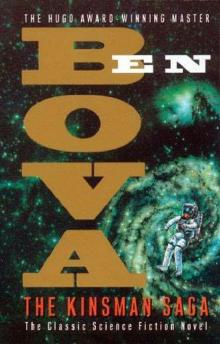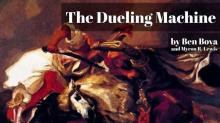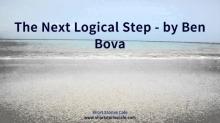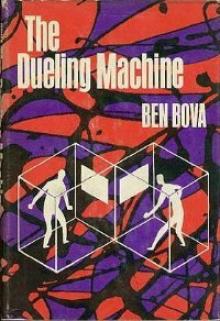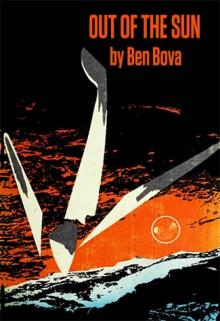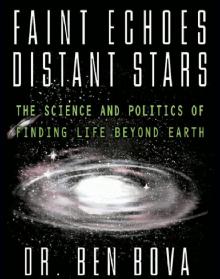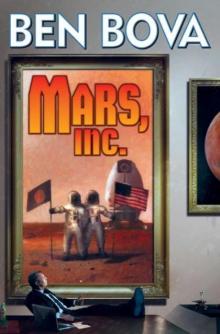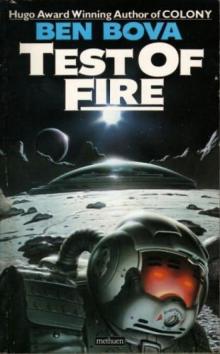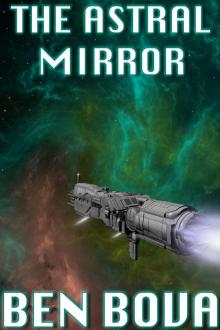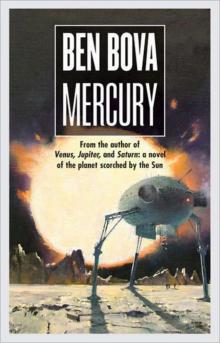Kinsman Saga, page 1





THE KINSMAN SAGA
by
Ben Bova
Author's Foreword:
Reality and Symbols
I HAVE RETURNED to where I started, returned to Chet Kinsman, to the character who has haunted me since I first began writing seriously.
If you have read the Tor Books edition of As on a Darkling Plain, you know the genesis of this book: How I wrote a very early version of it in 1949-50, a version that predicted the Space Race of the 1960s, which culminated in the American landings on the Moon. How Ihe novel was rejected everywhere, in part because publishers were afraid it would incur the wrath of anti-Communist witch-hunters such as Senator Joseph McCarthy. How Arthur C. Clarke encour- aged me to keep writing, and how eventually I was able to hand him the first copy of the first edition of Millennium.
When Millennium was originally published, in 1976, the idea of putting laser-armed satellites in orbit to shoot down nuclear-armed ballistic missiles was widely regarded as fan- tasy. Except by a few of us who knew better. Today the concept is known as the Strategic Defense Initiative, or Star Wars. Billions of dollars are being spent on it. Passionate arguments have been waged over it among scientists, politi- cians, pundits, and even science fiction writers. But in the early 1970s the only place that such an idea could be explored seriously in print, outside of classified technical publications, was in the medium called science fiction.
To the large majority of the public, science fiction is regarded as a field that deals with the fantastic, as far removed from reality as fiction can be. In truth, science fiction examines reality, and explores it in ways that no other form of literature possibly can. I must admit, though, that I am speaking now of my kind of science fiction, the kind that I write and the kind that I published when I was an editor. There are many other types of stories being marketed under the name of "science fiction." They may deal with unicorns or video games, barbarian swordsmen or robot killing machines. It is these types of stories, and the films and TV shows made from them, that convince most of the public that science fiction has no connection with reality.
My kind of science fiction examines the future in order to understand the present. It is social commentary of a new kind, a variety of literature that has been developed and sharpened in this century mainly by a handful of writers in the United States and Europe who are familiar with the physical sciences, their resultant technologies, and the impact of these technologies on society. Those of us who practice this art are agreed that modern technology is the major force of change in society today—and will continue to be, for the foreseeable future.
It seems clear that technological developments, from nuclear bombs to birth control pills, are the driving force in our civilization. The engines of change begin with the scien- tists and engineers. Then come the industrialists, churchmen, politicians, and everybody else. In our fiction we attempt to examine how science and technology bring change. We do not try to predict the future so much as to describe possible futures. We are not prophets warning of doom or describing Utopias, We are scouts bringing reports of the territory up ahead, so that the rest of the human race might travel into the future more safely and happily.
In Millennium, the concept of using lasers mounted aboard orbiting satellites to protect the nations of Earth from nuclear missile attack was both a symbol and a realistic extrapolation of technology. In science fiction, such a scientif- ic concept can be used both as a symbol and as a part of the authentic technical background for a story.
I knew in 1965 that a space-based defense against ballistic missiles was inevitable. I was working then at Avco Everett Research Laboratory, in Massachusetts, where the first truly high-power laser was invented. We called it the Gasdynamic Laser, and the first working model was built and operated under the supervision of the physicist with whom I shared an office. In its first ten seconds of operation, that crude labora- vi tory "kluge" produced more output power than all the lasers that had been built everywhere in the world since the first one had been turned on, five years earlier.
By January of 1966 I was helping to arrange a Top Secret meeting at the Pentagon to inform the Department of De- fense that lasers were no longer merely laboratory curiosities. It was clear, even then, that a device which could produce a beam of concentrated light of many megawatts power could be the heart of a defense against the so-called "ultimate weapon," the hydrogen-bomb-carrying ballistic missile.
The meeting we set up in the Pentagon was snowed out by one of the worst blizzards ever to hit Washington. If you ever want to take over the government, wait for a two-foot snowfall. You can then take ail of Washington with a handful of troops—if they have skis.
In February 1966 we finally met with the Department of Defense's top scientists and stunned them with the news of the Gasdynamic Laser. Seventeen years later an American President authorized the program that the media snidely calls Star Wars. I have told the story of the history, and future, of the Strategic Defense Initiative in a nonfiction book, Star Peace: Assured Survival, published by Tor Books in 1986.
But long before then, I used the very-real facts about laser-armed satellites as the background for my novel Millen- nium.
I had never given up on Chet Kinsman. He was too much a part of me, too deeply ingrained in my subconscious mind, I watched my first, unpublished novel become history as the Soviet Union did indeed put the first satellites and the first human space travelers into orbit and the United States roused itself to leapfrog the Russians and place the first men on the Moon. The way / had written it, that first step on the Moon was not made by Neil Armstrong; it was made by Chester Arthur Kinsman.
Kinsman would not let go of my imagination. I found myself writing short stories about him. He was a dashing young military astronaut who founded the Zero Gee Club, the first man to make love in weightlessness. He fought in orbit and killed a Russian cosmonaut, a shattering experience that altered his entire life. He got to the Moon, finally, and rescued a fellow astronaut who had gotten hurt while on an vil exploring mission. He battled the bureaucracy of Washing- ton, as any modern pioneer must, in his efforts to get the United States to return to the Moon.
While these stories were shaping themselves in my mind, while I was writing them and seeing them published in science fiction magazines, the outline of Millennium crystallized and came to life.
Once Millennium was published, readers reacted power- fully, especially to the ending. I was encouraged to bring together the stories dealing with Kinsman's early life, and I wove them into a second novel, Kinsman, a "prequel" to Millennium even though it was written several years after- ward.
In the meantime, of course, the scientists and engineers were making steady progress in the fields of space technology, lasers, and computers. So much so that in March 1983 President Reagan announced the start of the Strategic De- fense Initiative. Once again I watched my fiction start to turn into history. Nothing in the original Millennium and Kinsman has been invalidated by the events of the past few years. But now many of the details that I had to sketch minimally can be shown in much clearer perspective.
Now, in this single volume, the whole story is played out from beginning to end. From a brand-new lieutenant on a joyride in a supersonic Jet fighter plane to a man who literally carries the weight of two worlds on his shoulders. From a brash youngster who thinks of sex as nothing more than fun to a man who cares so much about the woman he loves that he is afraid of a relationship that will hurt her.
There are many differences between the original pair of novels and this new retelling of the Kinsman saga. For one thing, the human, emotional story of Kinsman and the woman he has loved all his life is told properly for the first time. Because the two novels were originally written the way they were, many details—and some larger aspects—of the story did not blend smoothly, one book to the other. Now they have been reexamined, rethought, and rewritten. All the characters and themes now mesh properly, and you can read the story of Kinsman's life from beginning to end as a single seamless garment.
The social and political implications of building a defense against nuclear attack, however, remain almost exactly as I originally wrote them. That is because they have not changed. The ultimate result of space-based defenses against nuclear attack will be a unified world government. There is absolutely no doubt in my mind about that. Who runs that government, what kind of a government it will be, what role the United States will play in it and what role other nations will play—all those questions are unanswered. Their answers will be the political history of the twenty-first century.
There are many symbols in Kinsman's story. I mention this mainly because most critics have been blind to them. Or perhaps they think of symbolism only in its psychological sense, where rockets are considered phallic and a wheel- shaped space station is thought to be vaginal. That is not the sort of symbolism I am speaking of.
Kinsman himself is a symbol. A young American male, full of the adventure of flying, who brings both love and death to the pristine realm of outer space. In Millennium, he becomes a Christ figure, and his closest friend, Frank Colt, takes on the role of Judas. Colt himself symbolizes the dilemma of the black man in modern America.
The Christian symbolism is at its plainest in the section of Kinsman where he rescues the injured astronaut on the surface of the Moon. In that tale, titled "Fifteen Miles" when it appeared in a science fiction magazine in its original form, the surface of the Moon becomes a testing ground, a place of ordeal and punishment. The central question is redemption:
&
The technological gadgets of the story also serve as symbols. Equating Moonbase's water factory with a human being's heart and blood is obvious enough. So, perhaps, is the symbolism of a lance of light that destroys the death machines of ballistic missiles. But the idea of humankind's reach into space forcing a change in human attitudes on Earth, which pervades the story of Kinsman's life, has escaped the atten- tion of most critics.
There are two aspects to this, in the story. One is the laser-armed satellites, the Star Wars system, placed in orbit to defend against nuclear missile attack. The other is weather control, using technology to tame one of the most fundamen- tal forces on Earth. Push and pull. Negative and positive. Yin and yang. The important point is that once the human race began to extend its ecological niche beyond the limits of planet Earth, all our old ways of thinking became doomed. Most people do not realize this yet. Most are oblivious to the fact that national borders are swiftly losing their meaning in a world of communications satellites, hydrogen bombs, conti- nent-spanning missiles, and the expansion of human life into space.
The facts are there to see, but most people are not emotionally prepared to deal with them. It is through the symbolism of fiction that we prepare our minds for these new concepts. In the truest sense, Chet Kinsman does exist, and his message of hope and peace and love is the ultimate reality.
—Ben Bova West Hartford. March 1987 Connecticut
BOOK
KINSMAN
Fear death?—to feel the fog in my throat,
The mist in my face, When the snows begin, and the blasts denote
I am nearing the place, The power of the night, the press of the storm,
The post of the foe, Where he stands, the Arch Fear in a visible form. Yet the strong man must go ...
—Robert Browning
Age 21
To Mark Chartrand, despite his puns
FROM THE REAR SEAT of the TF-15 jet the mountains of Utah looked like barren wrinkles of grayish brown, an old thread- bare bedcover that had been tossed carelessly across the floor.
"How do you like it up here?"
Chet Kinsman heard the pilot's voice as a disembodied crackle in his helmet earphones. The shrill whine of the turbojet engines, the rush of unbreathably thin air just inches away on the other side of the transparent canopy, were nothing more than background music, muted, unimportant.
"Love it!" he answered to the bulbous white helmet in the seat in front of him.
The cockpit was narrow and cramped. The oxygen he breathed through the rubbery mask had a cold, metallic tang to it. Kinsman could barely move in his seat. The pilot had warned him, "Pull the harness good and snug; you don't want anything flapping loose if you have to eject." Now the safety straps cut into his shoulders.
Yet he felt free.
"How high can we go?" he asked into the mike built into the oxygen mask.
A pause. "Oh, we can leave controlled airspace if we want to. Better'n fifty thousand feet." The pilot had a trace of Southern accent. Alabama, maybe, thought Kinsman. Or Georgia. "Thirty thou's good enough for now, though."
Kinsman grinned to himself. "A lot better than hang gliding."
"Hey, I like hang gliding," said the pilot.
"But it doesn't compare to this. . . . This is power.''1
"Right enough."
Power. And freedom. Six miles above the tired, wrinkled old Earth. Six miles away from everything and everybody. It 3 couldn't last long enough to suit him.
Ahead lay San Francisco and his mother's funeral. Ahead lay death and his father's implacable anger.
Life at the Air Force Academy was rigid, cold. A first-year cadet was expected to obey everybody's orders, not make friends. No matter that you're older than the other first-year men. A rich boy, huh? Spent two years in a fancy prep school, huh? Well, snap to, mister! Let me see four chins, moneybags! Four of 'em!
Yet that was better- than going home.
His father had refused to stop off in Colorado when he had taken his ailing wife from their estate in Pennsylvania to her sister's home in San Francisco. And Kinsman had delayed taking leave to visit his mother there. Time enough for that later, after his father had gone back East to return to running his banks.
Then, suddenly, unalterably, she was dead. And his father was still there.
Instead of taking a commercial airliner. Kinsman had begged a ride with a westward-heading Air Force captain.
If t'were done, he told himself, t'were best done quickly.
Now he was flying. Free and happy.
Suddenly the plane's nose dipped and Kinsman felt his pressure suit begin to squeeze the air out of him. His arms became too heavy to lift. His head felt as if it would sink down inside his rib cage. He could hear the pilot's breath, over the open mike, rasping in long, regular panting grunts, like a man doing pushups, and Kinsman realized he was breathing hard too. They were diving toward the desert, which now looked as flat and hard and gray as steel. The pressure suit squeezed harder. Kinsman could not speak.
"Try a low-level run," the pilot gasped, between breaths. "Get a real . . . feeling of speed."
The helmet on Kinsman's head weighed two million pounds. He made a grunting noise that was supposed to be a cool "Okay."
And then they were skimming across the empty desert, engines howling, rocks and bushes nothing more than a speeding blur whizzing past. Kinsman took a deep exhilarat- ing breath. The plane shook and bucked as if eager to return to the thinner, clearer air where it had been designed to fly.
He thought he saw some buildings in the blur of hills off to his left, but before he could speak into his radio mike the pilot blurted;
"Whoops! Highway!"
The control column between Kinsman's knees yanked back toward his crotch. The plane stood on its tail, afterburn- ers screaming, and a microsecond's flicker of a huge tractor- trailer rig zipped past the corner of his eye. The suit squeezed at his middle again and he felt himself pressing into the contoured seat with the weight of an anvil on his chest.
They leveled off at last and Kinsman sucked in a great sighing gulp of oxygen.
"Damned sun glare does that sometimes," the pilot was saying, sounding half annoyed and half apologetic. "Damned desert looks clear but there's a truck doodling along the highway, hidden in the glare."
Kinsman found his voice. "That was a helluva ride."
The pilot chuckled. "I'll bet there's one damned rattled trucker down there. He's probably on his little ol' CB reporting a flying saucer attack."
They headed westward again, toward the setting sun. The pilot let Kinsman take the controls for a while as they climbed to cross the approaching Sierras. The rugged moun- tain crests were still capped with snow, bluish and cold. Like the wall of the Rockies that loomed over the Academy, Kinsman thought.
"You got a nice steady touch, kid. Make a good pilot."
"Thanks. I used to fly my father's Cessna. Even the Learjet, once."
"Got your license?"
"Not yet. I'll qualify at the Academy."

